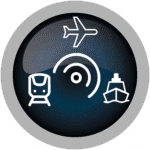
Smart transportation
Smart Transportation with NeoMesh
IoT is transforming the transportation sector, enhancing efficiency, safety, and passenger experience. By connecting physical infrastructure, vehicles, and assets to the digital world, transportation systems can become smarter, more responsive, and more cost-effective.
NeoMesh provides a robust and scalable wireless backbone for deploying battery-powered, infrastructure-free IoT devices, even in large-scale, high-mobility environments such as railways, ports, and public transport systems.

The Power of IoT in Transportation
With IoT, operators gain access to real-time data and analytics that improve everything from daily logistics to long-term planning. NeoMesh enables a wide variety of smart transportation use cases, such as:
Smart Train Operations
- Track individual mass transit vehicles using battery-powered modules
- Monitor vibrations to detect maintenance needs
- Detect door status, air quality (IAQ), and toilet conditions
- Enable smart seating with fluid spill detection and real-time occupancy monitoring
- Power overhead reservation displays that guide passengers to available seats
Logistics & Cargo Monitoring
- Monitor temperature and humidity in cold-chain/refrigerated transport
- Track cargo, containers and goods across transit routes
- Transmit sensor data from onboard systems on rail, road, or naval vessels
Smart Infrastructure
- Smart parking sensors to detect space availability
- Dynamic traffic lights that adapt signal timing to traffic flow
- Emergency systems, such as evacuation alert networks on vessels or stations
Overcoming Infrastructure Challenges
Conventional solutions like NB-IoT, LTE-M, and LoRaWAN often come with limitations:
- Subscription costs for each device
- Dependence on coverage from cell towers or gateways
- Limited bi-directional or peer-to-peer communication
- Challenges with latency and packet reliability in dense or mobile environments
NeoMesh — A Smarter Wireless Alternative
NeoMesh was built for challenging environments such as transportation networks, where mobility, scale, and reliability are critical:
No subscription fees
No ongoing costs per device
No field infrastructure needed
Devices connect directly to one another in a self-forming mesh
Only one cloud-connected gateway required
Connects via Wi-Fi, Ethernet, or 4G/5G
Reliable multi-hop communication
Data reaches its destination, even across long or obstructed paths
Long-range options available
Use LoRa modulation for several kilometers of device-to-device communication
Battery-powered, low-maintenance operation
Devices last for years without wiring or external power
Built-in redundancy and health monitoring
The network detects missing or failing devices automatically
NeoMesh makes it easy to deploy smart, connected infrastructure for transportation — whether you’re managing trains, tracking cargo, or building safer and more efficient cities.
Contact us to learn how NeoMesh can help drive your smart transportation initiatives.

